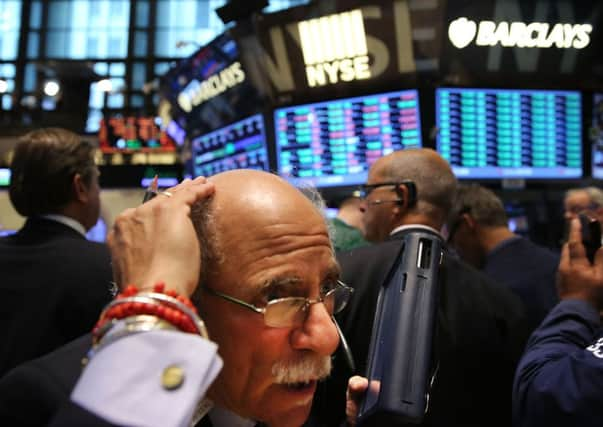Personal Finance: Recovery hasn’t yet hit savers


On 9 August 2007, French investment bank BNP Paribas told investors they couldn’t take money out of some of its funds because of a “complete evaporation of liquidity” in the market.
The announcement, which followed mounting speculation over the extent of sub-prime losses in the United States, triggered a series of debt write-downs as panic gripped the markets and banks stopped lending to each other.
Advertisement
Hide AdAdvertisement
Hide AdWeeks later, the run on Northern Rock heralded the start of the meltdown in the UK. Credit dried up as banks tightened their lending criteria, and savers suffered as the base rate plunged from 5.75 per cent in August 2007 to 0.5 per cent by March 2009.
And while there’s encouraging evidence of an economic upturn, the chain of events that unfolded seven years ago continues to have implications for personal and household finances.
For people dependent on the income from their cash savings the impact has been brutal.
Rachel Springall, at Moneyfacts, said: “The last seven years for savers have been devastating and the bank base rate drop wiped out much-needed levels of interest as banks and building societies priced down their deals.”
Seven years ago the average no-notice (or easy access) account paid 4.08 per cent and the typical notice account 4.23 per cent, according to Moneyfacts. Those averages now stand at 0.66 and 0.85 per cent respectively, with the drop accelerating since the funding for lending scheme compounded savers’ woes two years ago.
By giving banks access to cheaper funding the FLS reduced their need for savings deposits, with inevitable consequences for competition in the savings market. But the average savings rates only tell part of the story. Since 2007 the range of deals has contracted and the most attractive rates on offer now struggle to beat inflation.
Andrew Hagger, of Moneycomms.co.uk, said: “Seven years ago savers could get 6.7 per cent on a one-year fixed rate savings bond with Allied Irish bank and 6.25 per cent on instant access savings with Sainsbury’s and Citibank,” he said.
“Today’s rates are pitiful by comparison, with the top one-year bond at 2.01 per cent and the best easy access savings paying no more than 1.4 per cent.”
Advertisement
Hide AdAdvertisement
Hide AdThe only fillip for savers was the launch last month of the New Isa, which features an increased annual tax-free cash savings allowance of £15,000. But many of the UK’s high street banks have slashed their savings rates even further in recent weeks.
This week Barclays told more than a million Isa customers that they would be moved on to lower rates from November. Among those affected are people saving into its Freestyle cash Isa, some of whom will see their interest rate cut from 2.76 to 1.29 per cent.
And savers hoping for an improvement when the Bank of England finally increases the base rate could be dis- appointed.
“The noise surrounding a rate rise in the first half of 2015 is building but the increases are likely to be in small steps,” said Hagger. “Whether this will spell better returns for savers I’m not so sure as some banks may use the opportunity to increase margins rather than passing the full increase on to the consumer.”
The credit crunch has been kinder to borrowers, not least the homeowners able to take advantage of lower mortgage repayment rates. But while it’s easier to secure a credit card or a loan now than it was during the financial crisis, it can still be difficult for those without squeaky clean credit records.
The average credit card rate has risen from 16.3 to 20.2 per cent since August 2007, Moneyfacts figures show, while the cost of short-term personal loans has increased by a similar proportion. The average quote for borrowing £1,000 over one year is now 21.1 per cent, up from 16.8 per cent seven years ago.
However, there’s often a big difference between the loan and credit card rates that are advertised and those that borrowers can ultimately secure, said Hagger.
“The best buy deals are designed purely to drive high volumes of traffic via comparison sites – but many people will be disappointed and won’t get the deal they’re after,” he said.
Advertisement
Hide AdAdvertisement
Hide AdThat’s because just 51 per cent of successful applicants have to be offered the headline rate, meaning those with blemished credit records are likely to be quoted higher rates or even declined. And the cost of borrowing on credit cards or taking out a loan is expected to rise as speculation grows of an interest rate hike before the end of the year, Hagger added.
“I think we’ll see lenders adopting a more cautious approach and rates and interest free terms becoming less attractive,” he said.
Glasgow students ‘UK’s most financially savvy’
Students in Glasgow are among the most financially savvy in the UK, according to research published as school leavers prepare for university.
Glasgow students have an average term-time work income of £64.50 a week, compared with a UK average of £82.40 a week, the 2014 RBS Student Living Index shows.
The study suggests students in Glasgow spend 2.5 times their income level, compared with the national average of five times income and the Edinburgh average of four.
However, those in Glasgow typically spend more on their weekly groceries than elsewhere in the UK, at £28.90 compared with a UK average of £24.60.
Alcohol soaks up £9.80 of the average student budget and £8.60 a week goes on clothes.